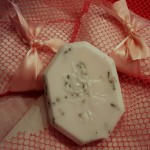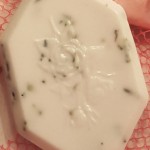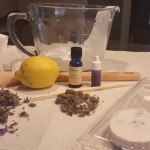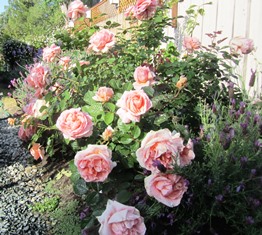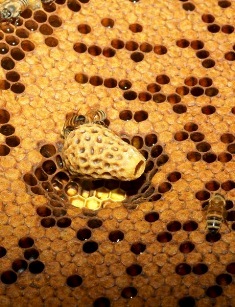Making Homemade Soap in Under an Hour
My grandmother grew up on a farm in Boone County, Missouri, and from spending a childhood with her I learned how to be frugal, self-sufficient, and someone who values time and efficiency.
On laundry day, she would whip out a big bar of grayish soap she’d made from an old country recipe and use it for scrubbing dirty clothes. The soap contained lye, grease, ammonia, borax, and water.
It looked like an ash-colored cake; I wouldn’t be surprised if it had some ash in it. That soap was utilitarian to be sure, but nothing you’d ever want use for a bath, although I suppose on occasion it might have been used.
Bath soaps have come a long way since the 1920s frugal creations of farm folks like my grandmother. Today, you can find exquisite artisan soaps–many are imported from France, Italy, and elsewhere–in a variety of colors, shapes, sizes, and scents. Or . . . you could make your own.
At hobby and craft stores, you’ll find soap-making kits that provide the basics for making soap in under an hour. You’ll also need some soap color to give your soap an appealing hue (otherwise, the soap comes out white). Finally, drops of your favorite essential oil will give your soap a sensual fragrance.
Recently, the birthday of a friend inspired me to quickly make a few bars of bath soap to wrap and tuck in my “spa” gift package for her. If you haven’t made soap before, start with a kit for soap making such as the one sold by ArtMinds and found in craft stores.
That particular kit uses a goats milk recipe with a suspension formulation that allows additives to float freely throughout the soap. This is important when you want to add to the soap rose or other flower petals or herbs like basil, lavender, or mint. The finished bar of soap lathers luxuriously and leaves your skin feeling squeaky clean.
Lavender-Scented Soap Using the ArtMinds Kit
Ingredients:
1 Goats Milk Soap Kit with 32 scored cubes
1 package of soap-making color (comes with blue, green, and purple); use purple for lavender soap
Lavender essential oil
Plastic sheet of soap molds
*Wooden spoon
*Pyrex glass measuring bowl or microwavable dish
*Do not reuse soap-making utensils or bowls for food service.
Directions:
Remove 10 cubes of “raw” soap formulation. Melt the cubes in a large glass measuring bowl for 30 seconds; if not completely melted, microwave in 10-second increments.
Add drops of lavender color until the desired hue is achieved. Add ten drops of lavender essential oil. Stir to thoroughly mix ingredients.
Pinch off the tiny florets of a sprig of fresh lavender. Drop into the soap and gently blend them in.
Pour the soap to the top of the mold(s). Let set for 20 minutes before removing the hardened soap. I suggest wrapping each soap individually to give as gifts.
For more resources, check out Marie Browning’s book, Natural Soapmaking (Sterling Publishing, NY) or visit Rebecca’s Soap Delicatessen at http://soapdelinews.com/2015/07/how-to-make-cold-process-soap-from-scratch.html
____________________________________________________
If you’re interested in farmette topics and storytelling, check out my Henny Penny Farmette series of mysteries. All three books in the series are available in numerous formats and can be ordered from Amazon, Barnes and Noble, and elsewhere online as well as from traditional bookstores everywhere. See more at http://tinyurl.com/ya5vhhpm
Propagating Plants from Rose Cuttings
Roses are among the most romantic flowers in a garden. I grow dozens of cultivars of rose bushes–climbers, hybrid teas, floribundas, and polyanthas. When I have an extra few dollars, I might spend it on a rose bush, but when money is tight, I simply start a new bush from one of my favorites that I’m currently growing.
My husband and I love the climbers. We have tall fences (over six feet) around our property on all sides. Covering an entire fence is easy when you use a vigorous, virtually pest-free climber. Two roses that quickly adapt and grow to fantastic heights are Sally Holmes and Cecile Brunner.
Climbing roses need strong support, since some canes can reach forty feet or more as they scramble over a roof or stone wall, trellis, fence, or arbor.
Last year, my husband created a rose arbor on wires strung from the fence along the north side of our house to the roof line. He planted the Cecile Brunner rose as his climber of choice. Its sage green leaves make a lovely foil for the tiny pink roses that permeate the air with a spicy-sweet scent throughout the spring. Cutting and feeding will render another bloom in summer.
My garden has plenty of places where I could tuck in a new rose bush, and I’ve bought many over the years. I have some favorites that I’d like to start in other areas. They include A Shropshire Lad, Handel, Lady Banks (a thornless yellow rose), and Iceberg.
This is the perfect time to propagate roses from cuttings in the Bay Area since the rose bushes in many yards are beginning to awaken. Roses require water, something no longer plentiful in California. Thanks to a severe four-year drought, we now have mandatory water restrictions. That means we gardeners must consider how we can recycle water, use gray water, collect water, and otherwise find ways to reduce water usage.
To propagate a rose from your favorite bush, take a six-inch cutting from a healthy cane. Make the bottom cut a sharp angle cut, not straight across. Do not crush the stem. Remove the leaves.
Dip the angle cut into a jar of root hormone powder. This powder enables the cane to root more easily in the ground or pot.
Insert the prepared cutting in the soil. Water as needed when the soil is dry. The cutting will need one to two months to root and then, it will begin to leaf out.
Some people like to put a quart jar over their cutting to create a mini-green house climate. In mild climates like the Bay Area, this isn’t necessary. The best time to propagate cuttings from your favorite roses is in the spring and never in extremes of cold or heat.
Creating romance in the garden could start with a table and chairs, floral-motif linens, and a service of tea. But even before those accoutrements to romance are added, why not fill the space with roses? It’s so easy.
The Inherent Gifts of Observation
I saw some wild turkeys today strolling through the acre behind the farmette. If I hadn’t noticed them, I wouldn’t have captured them on film. They disappeared as quickly as they showed up. You have to pay attention for the moment is soon lost.
Some people never lose that childlike wonder of noticing everything in their environment. My grandfather was like that–a veritable treasure trove of information based on the observations of his world. An attitude of gratitude seems to come easily to such individuals, as if noticing and feeling thankful are linked.
The Buddhist practice of mindfulness suggests that kind of noticing. For example, if you spot a flower while out walking (perhaps it even grows through a crack in the sidewalk), you might bend down to examine the flower. Does it offer a fragrance, beauty in its perfect symmetry, a ladybug on it’s stem, delicate leaf, or a gentle sway in the breeze as if it is dancing? These are the gifts the flower offers, the gifts it holds for you when you take the time to notice.
I like working with the bees and seeing up close their world within the hive. I had never seen a “queen house.” When I did for the first time I felt astonishment at how perfectly functional it was. Honeybees create comb to seal in the honey–their food (and ours)–and these honeycombs and queen houses are functional, perfectly formed, and beautiful to gaze upon.
For my grandfather (and also in my own experience) observing nature’s glory conjures feelings of appreciation for so many blessings–the ability to see, hear, feel, touch, think, and sense what is present, what co-exists around us. This renders the perspective that we humans are mere specks in cosmic creation.
Our lives are richer when we appreciate what we have and take time to notice how richly adorned our lives are.
 Facebook
Facebook Goodreads
Goodreads LinkedIn
LinkedIn Meera Lester
Meera Lester Twitter
Twitter





